The Main Principles Of Legacy Orthodontics
The Main Principles Of Legacy Orthodontics
Blog Article
The Only Guide for Legacy Orthodontics
Table of ContentsSome Known Details About Legacy Orthodontics Fascination About Legacy OrthodonticsLegacy Orthodontics for DummiesSome Known Details About Legacy Orthodontics Getting The Legacy Orthodontics To Work
At Advanced Orthodontics, we provide patients with a all natural treatment experience. Additionally, we provide adjustable treatment schedules, adaptable payment options and an enjoyable, enjoyable experience. invisalign. Call ( 480) 357-4900 today to learn more and timetable an appointment.An orthodontist is a dental practitioner educated to diagnose, protect against, and treat teeth and jaw abnormalities. They deal with existing problems and are trained to determine problems that may create in the future. Orthodontists work with people of every ages, from youngsters to adults. People typically connect a best smile with healthiness.
Malocclusion, or misaligned teeth, can lead to dental issues, including dental caries, gum illness, and tough or unpleasant chewing. Yet not everyone is birthed with straight teeth. If you have a bad bite or large spaces in between your teeth, you might intend to consult a dental practitioner specializing in orthodontic treatment.
Get This Report about Legacy Orthodontics
( Photo Debt: DigitalVision/Getty Images) Orthodontists make use of dealt with and detachable oral devices, like dental braces, retainers, and bands, to alter the setting of teeth in your mouth. Orthodontic treatment is for dental problems, consisting of: Misaligned teethBite troubles, like an overbite or an underbiteCrowded teeth or teeth that are also far apartJaw misalignmentThe goal of orthodontic treatment is to enhance your bite.
A healthy bite ensures you can consume, eat, and speak effectively. While you might assume of orthodontists as generally for kids or teenagers who require dental braces, they can correct oral issues at any age. Orthodontists go to college, oral college, and orthodontic school. After college graduation, they spend 2 or 3 years in an orthodontic residency program.
, yet not all dental professionals are orthodontists. They concentrate on two areas: Exactly how to effectively and securely move teeth Exactly how to correctly assist growth in the teeth, jaw, and faceOnce an orthodontist has completed training, they have the choice to become board licensed.
The Basic Principles Of Legacy Orthodontics
Imbalance, or malocclusion, is the most common reason people see an orthodontist. It is genetic and is the outcome of dimension differences between the top and reduced jaw or in between the jaw and teeth. Malocclusion leads to tooth overcrowding, an irregular jaw, or uneven bite patterns. Malocclusion is generally treated with: Your orthodontist connects metal, ceramic, or plastic square bonds to your teeth.
If you have just small malocclusion, you may have the ability to make use of clear braces, called aligners, as opposed to conventional braces (https://www.folkd.com/profile/340321-legacyortho/?tab=field_core_pfield_1). Some people require a headgear to aid relocate teeth right into line with stress from outside the mouth. After dental braces or aligners, you'll require to put on a retainer. A retainer is a personalized gadget that maintains your teeth in area.
They're most usually used on youngsters. They can produce extra room in the mouth without needing to draw teeth. If you have a severe underbite or overbite, you may require orthognathic surgery (also called orthodontic surgical treatment) to lengthen or reduce your jaw. Orthodontists utilize wires, explanation surgical screws, or plates to support your jaw bone.
You might require to see an orthodontist if you have: Crowding or not adequate room for all of your teethOverbite, when your upper teeth come by your base teethUnderbite, when your base teeth are also much forwardSpacing or concerns with gapsCrossbite, which is when your top teeth fit behind your bottom teeth when your mouth is closedOpen bite or an upright space between your front base and top teethMisplaced midline, when the center of your base and top teeth do not align Remedying an oral malocclusion can: Make attacking, eating, and talking easierImprove the symmetry of our face and your general appearanceEase pain from temporomandibular joint conditionsDifferent your teeth and make them simpler to clean, aiding avoid tooth degeneration or dental caries It's commonly a dental professional who initially notices misaligned teeth throughout a regular examination.
Unknown Facts About Legacy Orthodontics

Throughout your first orthodontic assessment, you'll likely have: A dental examPhotos taken of your face and smileDental X-raysPanoramic (360 degree) X-rays of your face and headImpressions to develop mold and mildews of your teethThese tests will certainly help your orthodontist know just how to continue with your treatment. leesburg braces. An orthodontist is a dental practitioner that's had training to treat your teeth and jaw
Orthodontists might carry out surgical treatment, exams,X-rays,and even more to aid you obtain a much more comfortable, healthier smile. An orthodontist is concentrated on your bite, so something like a cracked tooth would certainly be managed by a dental professional. Orthodontists are dentists however not all dental practitioners are orthodontists. Orthodontists are concentrated on your bite, or the method your teeth meshed, and the straightness of your teeth.
Ever questioned how celebs constantly appear to have flawlessly straightened teeth? The answer frequently depends on the skilled hands of an orthodontist. Yet just what does an orthodontist do? Orthodontists are oral professionals that concentrate on correcting irregularities in the teeth and jaws. Their expertise surpasses just producing a stunning smile; it includes enhancing your total dental health and function.
Not known Details About Legacy Orthodontics

While braces are the most commonly recognized orthodontic treatment, orthodontists have a diverse toolkit at their disposal. The certain approach selected relies on the severity of the case, the individual's age, and specific choices. These tried-and-true braces utilize a system of braces adhered to the teeth and linked by cables.
These removable trays are tailor-made to considerably change the teeth's position. In situations of narrow jaws, palatal expanders can be utilized to produce area for appropriate tooth positioning.
Report this page